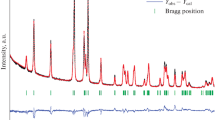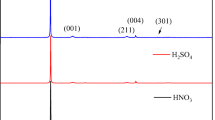Abstract
In this study, we reported tea polyphenols (TP) as a novel, cheap, environment-friendly and easy dissolution in common electrolytes reaction-type electrolyte additive for the graphite anode of the lithium-ion batteries. The TP can capture less stable radical anions that are harmful to oxidation stability of ethylene carbonate (EC) to form stable polymer. To a certain extent, it improved the electrochemical performance of the graphite electrode such as reversible capacity and cyclic stability by charge-discharge test, cyclic voltammetry (CV), scanning electron microscope (SEM), and electrochemical impedance microscope (EIS). The first charge capacities of the graphite electrodes in electrolytes without and with TP were 327.1 and 349.1 mAh g−1, respectively. The charge capacities were 306.8 and 344.2 mAh g−1 after 100 cycles and the capacity retention were 93.79 and 98.60%, respectively. The improvement was benefited from the effective scavenging the less stable radical anions and improvement the oxidation stability of EC and formation of a stable, compact and thin solid electrolyte interface (SEI) film with lower resistance.








Similar content being viewed by others
References
Moradi B, Botte GG (2015) Recycling of graphite anodes for the next generation of lithium ion batteries. J Appl Electrochem 46:123–148
He YB, Liu M, Huang ZD, Zhang B, Yu Y, Li B, Kang F, Kim JK (2013) Effect of solid electrolyte interface (SEI) film on cyclic performance of Li 4 Ti 5 O 12 anodes for Li ion batteries. J Power Sources 239:269–276. https://doi.org/10.1016/j.jpowsour.2013.03.141
Buqa H, Würsig A, Vetter J, Spahr ME, Krumeich F, Novák P (2006) SEI film formation on highly crystalline graphitic materials in lithium-ion batteries. J Power Sources 153(2):385–390. https://doi.org/10.1016/j.jpowsour.2005.05.036
Li S, Xu X, Shi X, Li B, Zhao Y, Zhang H, Li Y, Zhao W, Cui X, Mao L (2012) Composition analysis of the solid electrolyte interphase film on carbon electrode of lithium-ion battery based on lithium difluoro(oxalate)borate and sulfolane. J Power Sources 217:503–508. https://doi.org/10.1016/j.jpowsour.2012.05.114
Zhang SS (2006) A review on electrolyte additives for lithium-ion batteries. J Power Sources 162(2):1379–1394. https://doi.org/10.1016/j.jpowsour.2006.07.074
Zhao M, Zuo X, Ma X, Xiao X, Yu L, Nan J (2016) Diphenyl disulfide as a new bifunctional film-forming additive for high-voltage LiCoO 2/graphite battery charged to 4.4 V. J Power Sources 323:29–36. https://doi.org/10.1016/j.jpowsour.2016.05.052
Wagner R, Brox S, Kasnatscheew J, Gallus DR, Amereller M, Cekic-Laskovic I, Winter M (2014) Vinyl sulfones as SEI-forming additives in propylene carbonate based electrolytes for lithium-ion batteries. Electrochem Commun 40:80–83. https://doi.org/10.1016/j.elecom.2014.01.004
Wang R, Li X, Wang Z, Zhang H (2017) Electrochemical analysis graphite/electrolyte interface in lithium-ion batteries: p-Toluenesulfonyl isocyanate as electrolyte additive. Nano Energy 34:131–140. https://doi.org/10.1016/j.nanoen.2017.02.037
Jurng S et al (2016) Low-temperature characteristics and film-forming mechanism of elemental sulfur additive on graphite negative electrode. J Electrochem Soc 163:A223–A228
Abe K, Yoshitake H, Kitakura T, Hattori T, Wang H, Yoshio M (2004) Additives-containing functional electrolytes for suppressing electrolyte decomposition in lithium-ion batteries. Electrochim Acta 49(26):4613–4622. https://doi.org/10.1016/j.electacta.2004.05.016
Aurbach D, Gnanaraj JS, Geissler W, Schmidt M (2004) Vinylene carbonate and Li salicylatoborate as additives in LiPF3 ( CF 2 CF 3 ) 3 solutions for rechargeable Li-ion batteries. J Electrochem Soc 151(1):A23–A30. https://doi.org/10.1149/1.1631820
Aurbach D, Gamolsky K, Markovsky B, Gofer Y, Schmidt M, Heider U (2002) On the use of vinylene carbonate (VC) as an additive to electrolyte solutions for Li-ion batteries. Electrochim Acta 47(9):1423–1439. https://doi.org/10.1016/S0013-4686(01)00858-1
Liao L, Cheng X, Ma Y, Zuo P, Fang W, Yin G, Gao Y (2013) Fluoroethylene carbonate as electrolyte additive to improve low temperature performance of LiFePO 4 electrode. Electrochim Acta 87:466–472. https://doi.org/10.1016/j.electacta.2012.09.083
Shin H, Park J, Sastry AM, Lu W (2015) Effects of fluoroethylene carbonate (FEC) on anode and cathode interfaces at elevated temperatures. J Electrochem Soc 162(9):A1683–A1692. https://doi.org/10.1149/2.0071509jes
Xu SD et al (2013) New insight into vinylethylene carbonate as a film forming additive to ethylene carbonate-based electrolytes for lithium-ion batteries. Int J Electrochem Sci 8:8058–8076
Liu JQ, Zhuang QC, Shi YL, Yan X, Zhao X, Chen X (2016) Tertiary butyl hydroquinone as a novel additive for SEI film formation in lithium-ion batteries. RSC Adv 6(49):42885–42891. https://doi.org/10.1039/C6RA04839K
Ein-Eli Y, Thomas SR, Koch VR (1997) The role of SO 2 as an additive to organic Li-ion battery electrolytes. J Electrochem Soc 144(4):1159–1165. https://doi.org/10.1149/1.1837566
Besenhard JO, Wagner MW, Winter M, Jannakoudakis AD, Jannakoudakis PD, Theodoridou E (1993) Inorganic film-forming electrolyte additives improving the cycling behaviour of metallic lithium electrodes and the self-discharge of carbon—lithium electrodes. J Power Sources 44(1-3):413–420. https://doi.org/10.1016/0378-7753(93)80183-P
Simon B, Boeuve JP, Broussely M (1993) Electrochemical study of the passivating layer on lithium intercalated carbon electrodes in nonaqueous solvents. J Power Sources 43(1-3):65–74. https://doi.org/10.1016/0378-7753(93)80102-U
Besenhard JO, Castella P, Wagner MW (1992) Corrosion protection of LiC n anodes in rechargeable organic electrolyte batteries. Mater Sci Forum 91-93:647–652. https://doi.org/10.4028/www.scientific.net/MSF.91-93.647
Ein-Eli Y et al (1995) The dependence of the performance of Li-C intercalation anodes for Li-ion secondary batteries on the electrolyte solution composition. ChemInform 26:2559–2569
Lee JT, Wu MS, Wang FM, Lin YW, Bai MY, Chiang PCJ (2005) Effects of aromatic esters as propylene carbonate-based electrolyte additives in lithium-ion batteries. J Electrochem Soc 152(9):A1837–A1843. https://doi.org/10.1149/1.1993407
Wang C, Nakamura H, Komatsu H, Yoshio M, Yoshitake H (1998) Electrochemical behaviour of a graphite electrode in propylene carbonate and 1,3-benzodioxol-2-one based electrolyte system. J Power Sources 74(1):142–145. https://doi.org/10.1016/S0378-7753(98)00017-2
Ufheil J, Baertsch MC, Würsig A, Novák P (2005) Maleic anhydride as an additive to γ-butyrolactone solutions for Li-ion batteries. Electrochim Acta 50(7-8):1733–1738. https://doi.org/10.1016/j.electacta.2004.10.061
Shahabadi N, Maghsudi M, Kiani Z, Pourfoulad M (2011) Multispectroscopic studies on the interaction of 2-tert-butylhydroquinone (TBHQ), a food additive, with bovine serum albumin. Food Chem 124(3):1063–1068. https://doi.org/10.1016/j.foodchem.2010.07.079
Mukhtar H, Ahmad N (2000) Tea polyphenols: prevention of cancer and optimizing health. Am J Clin Nutr 71:1698s–1702s
Yang CS, Lambert JD, Sang S (2009) Antioxidative and anti-carcinogenic activities of tea polyphenols. Arch Toxicol 83(1):11–21. https://doi.org/10.1007/s00204-008-0372-0
Hu C, Kitts DD (2001) Free radical scavenging capacity as related to antioxidant activity and ginsenoside composition of Asian and North American ginseng extracts. J Am Oil Chem Soc 78(3):249–255. https://doi.org/10.1007/s11746-001-0253-8
Corongiu F, Banni S, Dessi M, Rice-Evans C, Pryor WA (1994) Free radicals and antioxidants in nutrition, volume VII : 437 pp., 1993. Free Radic Biol Med 17(5):489–489. https://doi.org/10.1016/0891-5849(94)90177-5
Akhavan O, Kalaee M, Alavi ZS, Ghiasi SMA, Esfandiar A (2012) Increasing the antioxidant activity of green tea polyphenols in the presence of iron for the reduction of graphene oxide. Carbon 50(8):3015–3025. https://doi.org/10.1016/j.carbon.2012.02.087
Dimov N, Fukuda K, Umeno T, Kugino S, Yoshio M (2003) Characterization of carbon-coated silicon: structural evolution and possible limitations. J Power Sources 114(1):88–95. https://doi.org/10.1016/S0378-7753(02)00533-5
Zhang XW, Patil PK, Wang C, Appleby AJ, Little FE, Cocke DL (2004) Electrochemical performance of lithium ion battery, nano-silicon-based, disordered carbon composite anodes with different microstructures. J Power Sources 125(2):206–213. https://doi.org/10.1016/j.jpowsour.2003.07.019
Chu YQ, Fu ZW, Qin QZ (2004) Cobalt ferrite thin films as anode material for lithium ion batteries. Electrochim Acta 49(27):4915–4921. https://doi.org/10.1016/j.electacta.2004.06.012
Choi WC, Byun D, Lee JK, Cho B (2004) Electrochemical characteristics of silver- and nickel-coated synthetic graphite prepared by a gas suspension spray coating method for the anode of lithium secondary batteries. Electrochim Acta 50(2-3):523–529. https://doi.org/10.1016/j.electacta.2003.12.070
Frei B, Higdon JV (2003) Antioxidant activity of tea polyphenols in vivo: evidence from animal studies. J Nutr 133(10):3275S–3284S
Liang J, Yan H, Wang X, Zhou Y, Gao X, Puligundla P, Wan X (2017) Encapsulation of epigallocatechin gallate in zein/chitosan nanoparticles for controlled applications in food systems. Food Chem 231:19–24. https://doi.org/10.1016/j.foodchem.2017.02.106
Naji A, Ghanbaja J, Humbert B, Willmann P, Billaud D (1996) Electroreduction of graphite in LiClO4-ethylene carbonate electrolyte. Characterization of the passivating layer by transmission electron microscopy and Fourier-transform infrared spectroscopy. J Power Sources 63(1):33–39. https://doi.org/10.1016/S0378-7753(96)02439-1
Chusid O et al (1993) Electrochemical and spectroscopic studies of carbon electrodes in lithium battery electrolyte systems. J Power Sources 43(1-3):47–64. https://doi.org/10.1016/0378-7753(93)80101-T
Holzapfel M, Martinent A, Alloin F, le Gorrec B, Yazami R, Montella C (2003) First lithiation and charge/discharge cycles of graphite materials, investigated by electrochemical impedance spectroscopy. J Electroanal Chem 546:41–50. https://doi.org/10.1016/S0022-0728(03)00144-X
Chang YC, Sohn HJ (2000) Electrochemical impedance analysis for lithium ion intercalation into graphitized carbons. J Electrochem Soc 147(1):50–58. https://doi.org/10.1149/1.1393156
Aurbach D (2000) Review of selected electrode–solution interactions which determine the performance of Li and Li ion batteries. J Power Sources 89(2):206–218. https://doi.org/10.1016/S0378-7753(00)00431-6
Levi MD, Aurbach D (2005) Distinction between energetic inhomogeneity and geometric non-uniformity of ion insertion electrodes based on complex impedance and complex capacitance analysis. J Phys Chem B 109(7):2763–2773. https://doi.org/10.1021/jp045788c
And MDL, Aurbach D (1997) Simultaneous measurements and modeling of the electrochemical impedance and the cyclic Voltammetric characteristics of graphite electrodes doped with lithium. J Phys Chem B 101:4630–4640
Aurbach D et al (1998) Common electroanalytical behavior of li intercalation processes into graphite and transition metal oxides. J Electrochem Soc 145(9):3024–3034. https://doi.org/10.1149/1.1838758
Aurbach D, Gamolsky K, Markovsky B, Salitra G, Gofer Y, Heider U, Oesten R, Schmidt M (2000) Study of surface phenomena related to electrochemical lithium intercalation into LixMOy host materials (M = Ni, Mn). J Electrochem Soc 147(4):1322–1331. https://doi.org/10.1149/1.1393357
Markovsky B, Levi MD, Aurbach D (1998) The basic electroanalytical behavior of practical graphite–lithium intercalation electrodes. Electrochim Acta 43(16-17):2287–2304. https://doi.org/10.1016/S0013-4686(97)10172-4
Xu SD, Zhuang QC, Tian LL, Qin YP, Fang L, Sun SG (2011) Impedance spectra of nonhomogeneous, multilayered porous composite graphite electrodes for Li-ion batteries: experimental and theoretical studies. J Phys Chem C 115(18):9210–9219. https://doi.org/10.1021/jp107406s
Shi YL et al (2011) Electrochemical impedance spectroscopic study of the electronic and ionic transport properties of NiF2/C composites. Int J Electrochem Sci 6:3399–3415
TIAN, et al. (2011) Mechanism of intercalation and deintercalation of lithium ions in graphene nanosheets. Chin Sci Bull 56(30):3204–3212. https://doi.org/10.1007/s11434-011-4609-6
Zhuang QC et al (2010) An electrochemical impedance spectroscopic study of the electronic and ionic transport properties of spinel LiMn2O4. J Phys Chem C 114:8614–8621
Cui Y, Yuan Z, Bao W, Zhuang Q, Sun Z (2012) Investigation of lithium ion kinetics through LiMn 2 O 4 electrode in aqueous Li 2 SO 4 electrolyte. J Appl Electrochem 42(10):883–891. https://doi.org/10.1007/s10800-012-0464-7
Zhuang QC, Li J, Tian LL (2013) Potassium carbonate as film forming electrolyte additive for lithium-ion batteries. J Power Sources 222:177–183. https://doi.org/10.1016/j.jpowsour.2012.08.050
Wang C, Kakwan I, Appleby AJ, Little FE (2000) In situ investigation of electrochemical lithium intercalation into graphite powder. J Electroanal Chem 489(1-2):55–67. https://doi.org/10.1016/S0022-0728(00)00197-2
Wang C, Appleby AJ, Little FE (2001) Charge–discharge stability of graphite anodes for lithium-ion batteries. J Electroanal Chem 497(1-2):33–46. https://doi.org/10.1016/S0022-0728(00)00447-2
Li T, Xing L, Li W, Wang Y, Xu M, Gu F, Hu S (2013) How does lithium salt anion affect oxidation decomposition reaction of ethylene carbonate: a density functional theory study. J Power Sources 244:668–674. https://doi.org/10.1016/j.jpowsour.2012.12.062
Ushirogata K, Sodeyama K, Okuno Y, Tateyama Y (2013) Additive effect on reductive decomposition and binding of carbonate-based solvent toward solid electrolyte interphase formation in lithium-ion battery. J Am Chem Soc 135(32):11967–11974. https://doi.org/10.1021/ja405079s
Eom KS, Jung J, Lee JT, Lair V, Joshi T, Lee SW, Lin Z, Fuller TF (2015) Improved stability of nano-Sn electrode with high-quality nano-SEI formation for lithium ion battery. Nano Energy 12:314–321. https://doi.org/10.1016/j.nanoen.2014.12.041
Funding
This work was supported by the Fundamental Research Funds for the China University of Mining and Technology (2017XKQY063).
Author information
Authors and Affiliations
Corresponding authors
Electronic supplementary material
ESM 1
(DOC 1768 kb)
Rights and permissions
About this article
Cite this article
Bian, S., Liu, M., Shi, Y. et al. Tea polyphenols as a novel reaction-type electrolyte additive in lithium-ion batteries. Ionics 24, 1919–1928 (2018). https://doi.org/10.1007/s11581-018-2445-2
Received:
Revised:
Accepted:
Published:
Issue Date:
DOI: https://doi.org/10.1007/s11581-018-2445-2




